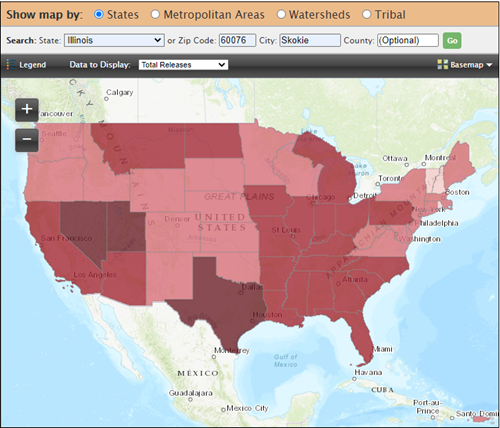Use EPA Interactive Map to Find Out Hazardous Chemical Releases Near You
Written By: Atanu Das on Tuesday, January 26, 2021
The map collects data from manufacturers reporting the amounts of certain chemicals on the Toxic Release Inventory annual report. The most recent data is from the 2019 reporting year.

The top ten states with the highest releases are as follows:
| Row # | State | Total On-site Disposal or Other Releases | Total Off-site Disposal or Other Releases | Total On- and Off-site Disposal or Other Releases |
|---|---|---|---|---|
| 1 | Alaska | 851,618,326 | 561,793 | 852,180,119 |
| 2 | Nevada | 332,618,677 | 3,877,570 | 336,496,247 |
| 3 | Utah | 195,746,653 | 2,768,502 | 198,515,155 |
| 4 | Texas | 158,684,465 | 29,840,523 | 188,524,988 |
| 5 | Louisiana | 129,328,508 | 4,747,850 | 134,076,358 |
| 6 | Indiana | 84,144,736 | 39,182,714 | 123,327,451 |
| 7 | Ohio | 76,615,898 | 27,364,207 | 103,980,105 |
| 8 | Illinois | 54,093,622 | 44,729,796 | 98,823,418 |
| 9 | Arizona | 84,453,330 | 1,398,381 | 85,851,711 |
| 10 | Tennessee | 70,170,725 | 12,286,699 | 82,457,425 |
Alaska, with 852 million pounds, was the top state for releases, in part because of the large number of metal mines in the state. Metal mines tend to have high releases because of the large quantities of metals disposed of on-site, the EPA said.
The same is true for the next two states: Nevada with 336 million pounds and Utah at 199 million pounds.
Texas was fourth at 189 million pounds and Louisiana was fifth with 134 million pounds. Those states are home to chemical manufacturing facilities that treat chemicals on-site, such as ethylene, toluene, and propylene.
The TRI program tracks more than 770 chemicals that can cause cancer or other harmful health effects in humans or otherwise cause damage to the environment. They include chemicals such as hydrochloric acid, nitrate compounds, sulfuric acid, dioxins, ammonia, benzene and toluene.
Typically larger facilities in the U.S. involved in manufacturing, metal mining, electric power generation, chemical manufacturing and hazardous waste treatment must report annually how much of each chemical is recycled, burned for energy recovery, treated for destruction and disposed of, or otherwise released on- or off-site.
A "release" means the chemical is emitted to the air or water or placed in some type of land disposal.
The EPA said these facilities avoided releasing 89% of the chemical-containing waste they created and managed during 2019 into the environment by using recycling, treatment and energy recovery.
